Metroid Prime 3: Quarterly Diaries #12
November 17th, 2009

Areas Covered: Command Center (revisited), Phazon Mining Site
Discussion Points: “Sticky” map hints, purpose of mining site, Main Cavern set piece, nova beam
Command Center (revisited)
Surprisingly, the time spent back in the Command Center is reasonably short as you blow through a single line of defence (the voltage shield in the Command Courtyard) and cruise on through to another transit hub. Contrary to the little time that needs to be spent here, I actually wasted a lot of time unnecessarily exploring, thinking that I’d have a plethora of new rooms to explore with my updated arsenal, as well as being thrown off by another incorrect map hint.
This time the map prompts points you towards Skyway Access, yet once you arrive security kicks in, automatically placing the room on lockdown, enemies swarm in, a short battle ensues and then a morph ball tunnel diverts you back into a previously explored area (Defense Access). Actually, you’re suppose to use the spider ball to reach the transit station from Defense Access, but the map system keeps hinting you towards Skyway Access (which you must return to later), so like any good Metroid player I trusted what the game’s instructions and got screwed over for it, again!
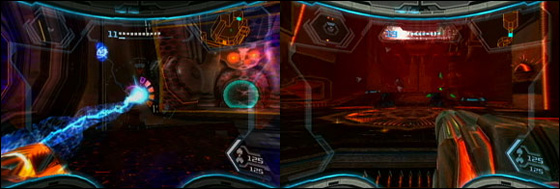
“Sticky” map hints have been discussed previously, and the solution to the problem is very easy: switch them off as soon as the player has entered the appropriate room, furthermore be more discreet in diverting the players attention towards the next, succeeding route. If a room is marked as a hint by the map and the player is required to first enter the room, leave and then return later with some other power-up, then the hints should bend to fit this situation (this has not been the case with the previously stated examples). From my experience, these minor annoyances can quite easily confound into a few hours of time-wasting. Not to downplay the criticism, but relatively speaking, they’re just minor blotches on a overly well paced game. Perhaps other players who don’t over-think things like me wouldn’t have succumb to the same pitfalls. I’m not sure, any comments folks?
Phazon Mining Site
The transit station takes us out to the Phazon Mining Site giving credence to the logbook entries earlier in the game and throughout Metroid Prime 2 where the pirates discussed their intersection with the hazardous catalyst. The Mining Site serves only to provide the player with the Nova beam, the final beam upgrade which will help open up the Skyway Access to lead the invasion a little later. It’s a short linear plough and just like the former sequence and the sequence which follows (an action-heavy set piece), the linearity is used to concentrate the pacing into a steady climb in preparation for the final set piece sequence.
In the first major room (Phazon Quarry) the player can use a touch pad to interface with a huge mining drill to clear a path. There are two areas that can be drilled and, as has been a reoccurring theme throughout the last few posts, either choice yields reward. There is no proper interplay between the player and the drill, making the sequence feel artificial.
Mine Lift, the following room, has Retro again playing with verticality in a well stylized manner. We’ve seen similar sequences before on Elysia and in the Imperial Caverns. Phazon Harvesting, the room just after it sees a little more experimentation too, this time with a Phazon Harvester dealing out massive damage through a pulse beam destined to send you off the narrow set of platforms.
The following section may be difficult to picture if you haven’t played this sequence before, the tail end of this video features the sequence in question. Mind the commentary.
When you reach the Main Cavern you arrive on an upper floor viewing platform overseeing a circular chamber glassed off in the centre. Functionally every room within the mine corresponds to the mining of Phazon ore, the circular room in this case acts as a giant suction tank for the ore chiseled-off from the perimeter outlined with phazon rock. Basically, the pirates chisel away at the walls for a minute or so, an alert signals, handrails rise up from the ground so that the pirates can stay grounded while the suction is taking place. It’s a somewhat unsafe work practice, but the premise makes for one of the most clever set pieces moments in the trilogy yet.
When the player enters the central room, the doors quickly closed off, pirates flood in and four totem poles raise from the floor, ostensibly it’s another clichéd run-in with the pirates. In this state the room acts as something of a stadium for a spectator sport. There’s tunnels for combatants to file in, a viewing platform for onlookers and an arena in which—through the raised totem poles—creates an interesting target/prey dynamic. Trusting my familiarity with the series I safely assumed that once I’d cleared the four initial pirates, everything would be over. After four or five waves of pirates and my first confrontation with the game over screen, I realized this wasn’t the case.
A minute or so into the battle, each of the pirates will rush to one of the four respective sets of handrails and, as mentioned before, the vacuum will begin it’s suction, drawing Samus into the centre and damaging her if she succumbs to the pressure. It’s in these sections where the player must push against the force whilst simultaneously shooting the pirates in an attempt of throwing off their grip and sending them into the vacuum, thereby revealing four weak points which the player can chip away at.
This binary construction creates an engaging attack/defend dynamic between the two states. In the initial state, with totem poles raised, the player must defend themselves from the pirate onslaught whilst at the same time weakening them in preparation for the next phase. If the player becomes too hasty and preemptively kills (!?) a pirate, another one will shuffle in, taking it’s place. It’s integral then that the player finds a steady balance between attacking and defending. The arena is constructed in a such a way—totem poles provide temporary but never full protection from the onslaught and the AI is smart enough to flush you out, forcing the player to constantly adapt to the shifting situation—that it constantly demands the player’s attention.
The second phase inverts the roles of the combatants in this stadium of ours, continually feeding into the attack/defend dynamic. This time, the player’s role is switched and the offensive takes the priority, although defence against the vacuum is still very important. The pirates are vulnerable and the player is free to weaken their grip (no health=loss of grip), yet the player must also be cautious of the inwards pull and at all times have their left thumb pushing the control stick in the opposite direction of the force.
As you can see, the gameplay throughout this sequence is engaging by the way the arena design, enemy AI and vacuum mechanic are constructed to have the player move between roles supporting polar mixes of offence and defence, both of which are dynamic and multifaceted.
Your reward for this area is the Nova beam and the trek to the landing zone from which we can fly back to the Command Center works as a tutorial for this device. The beam works with the X-ray visor to shoot out weaknesses in phazon walls, it’s a nice way to unify the two mechanics, especially considering that the ice and fire properties have already been covered. The beam is also considerably more powerful than the last.
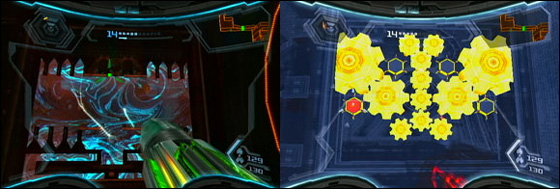
I also noticed that the alarms throughout the Pirate Homeworld pass on from room-to-room Metal Gear 2 style, whereas this may have not been the case in the previous two games. Not sure if my memory serves me well there.
Lastly, it’s somewhere around this part of the game that the log book scans continue to delve into the backstory of trilogy, leading right into the events on Norion, Bryyo and Elysia.
Additional Readings
The Most Stunning Metroid-Inspired Artwork
Linkout (15/11/09)
November 15th, 2009

Link Out: My attempt at a monthly collection of recommended readings from around the interwebs
Thank you for your patience over this past week as I’ve been rounding out my last major university assignment (ever!). Fortunately, I’ve got no exams so I’m basically free for a week until I start my 4 week long TESOL course which’ll likely continue the disrupted flow of new posts leading into Christmas. *sigh* I have plenty to write, but little time to apply myself, so we’ll see how this next week fairs.
As tradition would have it, it’s been a long time between links (ZING!), so I’d like fix that for now:
Prince of Persia: The Sands of Time Movie Trailer
Finally we get to see how the Prince of Persia movie is shaping up, and as the trailer clearly showcases it looks fairly promising. As another Hollywood blockbuster, that is, but for the same reasons I criticized the Sands of Time game, it looks like the movie will be another western parade though a superficial interpretation of the Middle East. Yay!
Otherwise, the film appears to draw most of its influence from The Two Thrones, things could be worse I suppose.
Forums – To Read, or Not To Read – Too Much Imagination
In keeping with the Prince of Persia theme, the following post is taken from the blog of Ben Mattes who you might know from his role as a producer on the later Prince of Persia games. His post, primarily regarding community forums, shares some interesting insight into the mindset of developers towards the enthusiast community.
I really wish there was greater interaction between the two parties as the analysis here and elsewhere around the interwebs is basically the type of well thought out feedback from concentrated play testing that most companies would pay money for. They can get it for free from us! Furthermore, considering the effort that some of us put into our writing, I think that most enthusiast writers (along this vein) would be profoundly motivated by any engagement with developers. I know that some of the people from Sony Bend have read my articles on Syphon Filter, which makes my heart skip a beat. Although, I’ll admit, I was considerably less enthusiastic about PopCap’s response. Still, any interaction is likely to have a positive effect.
I’m guilty of throwing Eurogamer a few too many links in this segment, but with such well articulated analysis and opinions (Simon Parkin’s powerful review of Modern Warfare 2 is one of the best pieces of writing I’ve read all year) it’s difficult not to be enthused. The above video chronicles the rise of the website from humble beginnings to it’s current state. The multiplatform, Australian equivalents such as PALGN will have to grow some serious editorial balls before they can attempt to contend with the likes of Eurogamer.
COLUMN: Battle Klaxon: The People Power of Valkyria Chronicles – GSW
Battle Klaxon is my favourite new column over at GameSetWatch. Quintin Smith, who incidentally also works for Eurogamer, covers niche gems neglected by the mainstream games press, describing what made them so special for the people who played them. Valkyria Chronicles is an ideal choice for the column, I’ve played a bit of this Fire-Emblem-meets-Final-Fantasy-Tactics-SRPG-hybrid, but am yet to make enough headway to make any qualitative observations. What I can say though is that I’m an ardent, SRPG purist who adores both of the two previously mentioned titles, so Valkyria Chronicles will probably come to sit in the middle of those two titles. Almost every blog in my feed reader is now centred around retro and/or niche titles, so Battle Klaxon is a welcomed addition to the diet…
Metal Gear – MSX and NES Comparison – Hardcore Gaming101
…as is Hardcore Gaming 101. Yes, this site is not new to me, I’ve been reading them for years, and yes I’ve known about their new blog since it had launched. For some unfathomable reason though I forgot to subscribe to the site the first time round back in July/August and it flew off my radar. Thankfully I spent a few hours whoring out the backlog recently and have left suitably impressed. I chose the above, Metal Gear article as my favourite post on the site so far as it reflects the exhaustive dedication that Kurt Kulata and his crew of contributors put into their work. Mega effort, well done folks. Kurt was also recently interviewed on the first episode of the Racketboy podcast, props to those guys too.
I’ve kind of strayed off the path myself when it comes to reading the Brainy Gamer blog, simply because my tastes have adjusted to more analysis/criticism-heavy reading, rather than Michael’s handful of general commentaries (great stuff, naturally, but very general, lacks explanation and example). With that said though, Michael is very good at summarising community consensus. His article reflects on his personal response to the mainstream rollercoaster of game release. Rather than playing the latest AAA blockbuster on the scene, Michael is finding that he prefers the smaller, older and perhaps even neglected titles of the industry. I can definitely sympathize with his feelings here. I stopped trying to chase the mainstream rat race years ago and it’s been wonderful because I save money and get to blaze my own path of writing, rather than bucking to popular trends. This is a superbly written post which intersects with the ethos of the site, so do take a read.
The Monthly Grind: Final Thoughts on Demon’s Souls – The Grind
Considering it’s niche appeal, Demon’s Souls has been receiving a great deal of coverage from blogs and the enthusiast outlets. I’ve been following the conversations myself and I think Kat Bailey is the furthest ahead of the curve on her analysis of the title. In concluding on her one month play through of Demon’s Souls she draws on her analysis and discussions with others to explicate on the different viewpoints regarding the title—the split being that players find it either unrelenting in difficulty or a supremely rewarding experience—she backs the latter and uses her deconstruction of both perspectives to persuasively argue in favour of the title. It’s clear that much consideration has been put into dissecting the different interpretations and to this end I’m very impressed. The Mt. Fuji anecdote and bad Thai food metaphor (gosh, so true) are expertly handled and make the article personal and therefore meaningful. This is a good article to highlight the strengths of the medium.
Extra Links
A First Look At Two of The PS3’s Newer, Funnier Ads
Proof that Sony have some of the best marketers in the world. ^_^
The last few months of delicious links
Microtransactions: ‘Non-Interactive Sequences, the Author and the Player’ and ‘Super Mario RPG and Alternative Dimensions’
November 2nd, 2009
Microtransactions:A randomised assortment of ideas too big for Twitter and too short for their own posts, neatly compiled into their own reoccuring segment.
NB: I’ve been working hard to continue the stream of Metroid Prime 3 articles, but as I round out my final few weeks of Uni I’ve had to fall back on banked material. I hope you don’t mind, I’ll be back with the program as soon as I can. Thanks.
Super Mario RPG and Alternative Dimensions
Gosh, what a peculiar game. As I said on Twitter sometime outside of recently “Playing Super Mario RPG (VC) is like opening the door to an alternative dimension.”. A couple of people misinterpreted my tweet though, so allow me to quickly elaborate as the remark has a few meanings:
Super Mario RPG was originally never released in PAL regions. In Australia, the most amount of information we’d ever received on the title prior to release was in a special RPG issue of Nintendo Magazine System (our equivalent of Nintendo Power). This issue was famously dubbed the “RPG issue” because of a massive feature spread over several pages previewing the now famous JRPG avalanche which hit the Super Nintendo late in its lifetime. (I think they also reviewed a handful of RPGs which were placed at the start of the review section to keep in theme, but I can’t quite recall now.) The magazine, unsurprisingly, featured Super Mario RPG on the cover. Ironically tough, most of the spotlighted games featured in the magazine wouldn’t see a PAL release until years later, a good majority of those on the PSone, GBA and DS—and not on the SNES—including Final Fantasy VI and Chrono Trigger.
As you can imagine the issue was something of a holy grail for RPG enthusiasts in Australia. Considering the popularity of the magazine and the rather dormant state of the internet, for many of us, this was likely our first real insight into these now iconic games. Unfortunately, for many of them, it ended up being a long tease. In the case of Paper Mario a tease that dragged on for 12 years, until it landed on the Wii’s Virtual Console service a year ago.
Therefore, as you can imagine: “Playing Super Mario RPG (VC) is like opening the door to an alternative dimension.”, stepping into the past and reclaiming what was once lost.
The second point of my tweet is simply to make the same remark players were making a decade ago, that is: the collaboration sure is an interesting one. The sad thing about this industry is that publisher’s rule the roost. Unlike in other media, it isn’t as easy for one developer to do their own interpretation of another developer’s property, even if the original developer permits. The whole process lies within the hands of the publishers who, in effect, legally internalize the creations of their developers.
Interpretations of other work therefore rarely happen, only in the rare instances where such interpretations and crossovers are managed internally or allowed by the owner of the intellectual property. Metroid: Other M is a great example, as is Capcom Vs SNK, SVC: Chaos and Namco X Capcom. Super Mario RPG is too a great example and was very much unprecedented for its time as it was one of the first interpretations of a franchise by someone other than the original creators (Wolfenstein 3D is another example, anyone have any more ideas?). For these reasons Super Mario RPG therefore felt unique, and playing it today still emits this alluring quality.
Non-Interactive Sequences, the Author and the Player
One of the core complaints leveled against Super Paper Mario and Metal Gear Solid 4 was the length of their non-interactive sequences. Super Paper Mario was too chatty and MGS4 can be considered as a game interwoven with a feature film. I know people have defended both games on the basis that the content in these sequences are actually quite good—and therefore doesn’t deserve the bad press—so I’d like to weigh in by agreeing with the assertion that so long as the content within these sequences actually serves a meaningful purpose, then they’re perfectly fine with me. (Meaningful purpose being a subjective term depending on the individual player). Of course, in saying this, MGS4 did have too much cyber babble and Super Paper Mario‘s dialogue did stretch the point at times. These are rather legitimate claims relative to other games on the market.
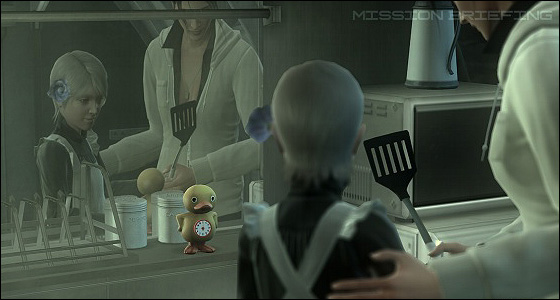
Games are a shared product between the designer and the player. The designer wants the player to experience certain things within their game, they want them to, to some degree, think in a certain way and act per se. The designer coerces the player’s actions by designing the nature of the world, but the designer isn’t the director, the player is. The player co-authors the experience. When the designer forces the player through a non-interactive sequence, the designer takes control from the player and pushes their own agenda. In this regard, I think that the designers and writers of MGS4 and Super Paper Mario became too invested in the messages they wanted to transmit during these sequences that they became overly directive of the experience and ultimately damaged the game(s).
I always go into a new game with the intent of being reasonable. Anything (side quests, narrative, sequences of gameplay, mechanics etc) that I feel as meaningless or damaging towards my experience, I won’t participate in. Although I read the majority of dialogue in Super Paper Mario, much of it I also skipped or skim-read simply because it dragged on and impeded on my experience. It’s the same reason why I’m disinterested in trophies for the Playstation 3, they just artificially lengthen the game. I personally don’t believe that the value proposition they’re offering me is worthy of committal—as we’ve discussed, this can feel like work. Not every player shares this view though, my work might be someone else’s challenge and so forth. It’s the subjective nature which makes designing games very tricky.




 Game Design Companion: A Critical Analysis of Wario Land 4 - $7.99
Game Design Companion: A Critical Analysis of Wario Land 4 - $7.99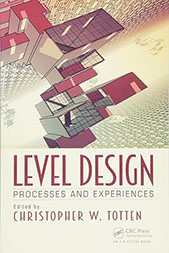 Level Design: Processes and Experiences
Level Design: Processes and Experiences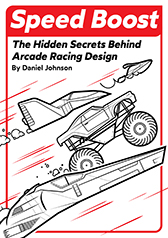 Speed Boost: The Hidden Secrets Behind Arcade Racing Design - $5.99
Speed Boost: The Hidden Secrets Behind Arcade Racing Design - $5.99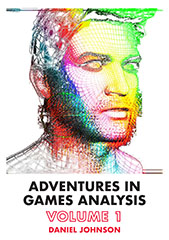 Adventures in Games Analysis: Volume I - $5.99
Adventures in Games Analysis: Volume I - $5.99







